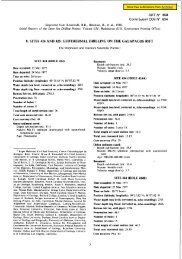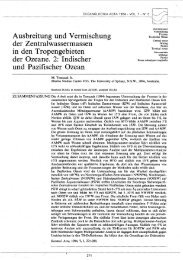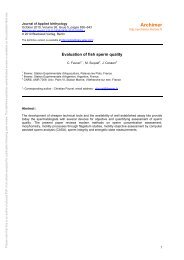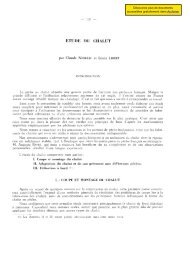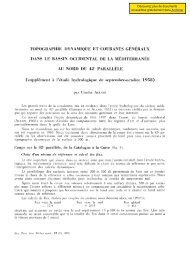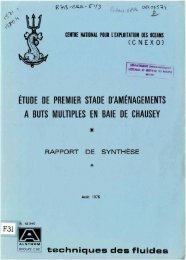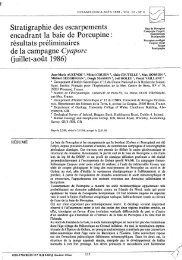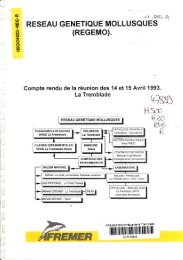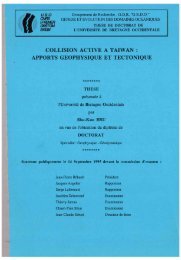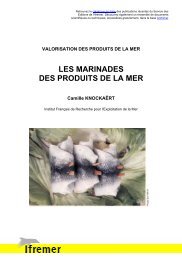Contribution à l'étude de virus de mollusques marins apparentés ...
Contribution à l'étude de virus de mollusques marins apparentés ...
Contribution à l'étude de virus de mollusques marins apparentés ...
Create successful ePaper yourself
Turn your PDF publications into a flip-book with our unique Google optimized e-Paper software.
than at high temperature (25-26°C) and consi<strong>de</strong>ring the respective breeding temperatures, larval<br />
growth rates obtained here were of standard values (A. Gérard personal communication).<br />
Compared to survival rates, herpes<strong>virus</strong> particles were found in groups of oyster larvae in which high<br />
and sud<strong>de</strong>n mortalities occurred. A further comparison of light and transmission electron microscope<br />
analysis with survival rates at 25-26°C may also reflect the rate of <strong>virus</strong> <strong>de</strong>velopment in larvae. This is<br />
weil iIIustrated with oyster larvae from La Trembla<strong>de</strong> reared at 25-26°C. In this group, <strong>virus</strong> particles<br />
could be observed in 100% larvae as soon as day 8, while light microscopy revealed only 49% larvae<br />
containing nuclear lesions. This difference is thought to reflect that weak viral infection could not be<br />
<strong>de</strong>tected easily by light micrascopy. On day 13, at a further stage of viral infection, 100% larvae<br />
examined by light microscopy were found to exhibit nuclear lesions, these larvae are in<strong>de</strong>ed heavily<br />
infected and larval mortality reach 100%. Observations ma<strong>de</strong> on groups of larvae from Marennes and<br />
Arcachon reared at 25-26°C are in agreement with this hypothesis.<br />
ln this study, viral particles could only be observed at 25-26°C. A similar feature was reported by<br />
Farley (1972) wh en adult C. virginica suffered a high mortality (52%) associated with herpes-like <strong>virus</strong><br />
infection when held at 28-30°C, versus control animais reared at 12-18°C (18% mortality) in which no<br />
viral infection was found. However, nuclear alterations were histologically observed here, in animais<br />
reared at 22-23°C, although not associated with the presence of viral particles at the ultrastructural<br />
javel. Moreover, no other pathogen susceptible to provoke such lesions was observed. These nuclear<br />
abnorrnalities could result either from a low productive viral cycle in which viral particles are very rare.<br />
But also from a non productive state, in which viral particles are not produced. In this last case, Iwo<br />
hypothesis may be <strong>de</strong>veloped. First, these nuclear alterations could result fram a viral pratein<br />
expression associated to a true latent viral phase (Meyers, 1979; Garcia-Blanco and Cullen, 1991).<br />
Second, nuclear alterations could result from an abortive viral cycle, in which only some early phases<br />
of the viral cycle are achieved, with synthesis of structural or functional proteins and eventually viral<br />
DNA replication, but without any production of virions (Girard and Hirth, 1989). Consequently,<br />
structural aspect of the infected cell nuclei would change. It is important ta note that for <strong>virus</strong>es<br />
belonging ta the Herpesviridae, a low productive or an abortive viral cycle are generally associated with<br />
a further switch of the <strong>virus</strong> to a latent stale (Girard and Hirth, 1989).<br />
107



